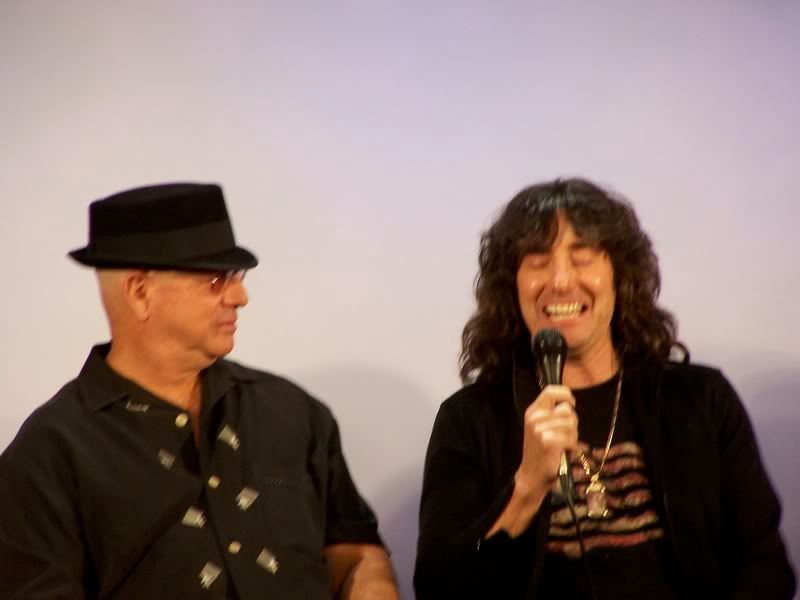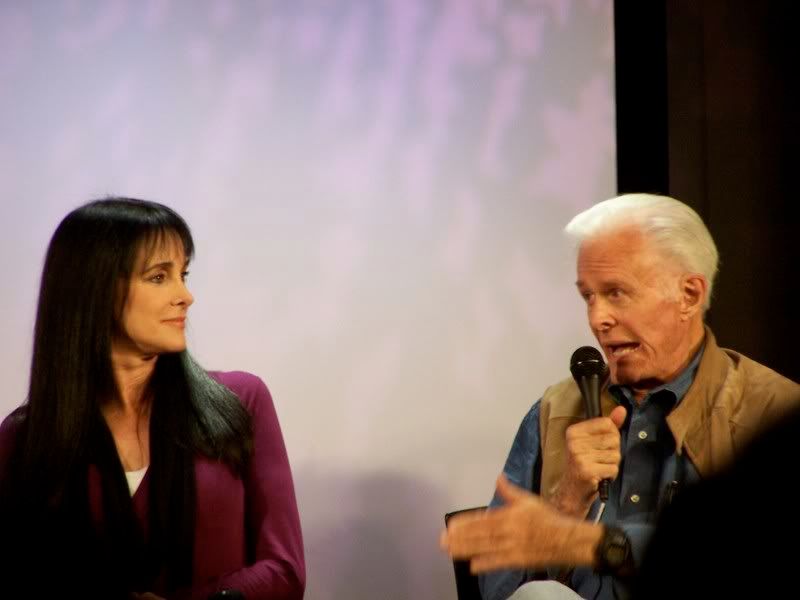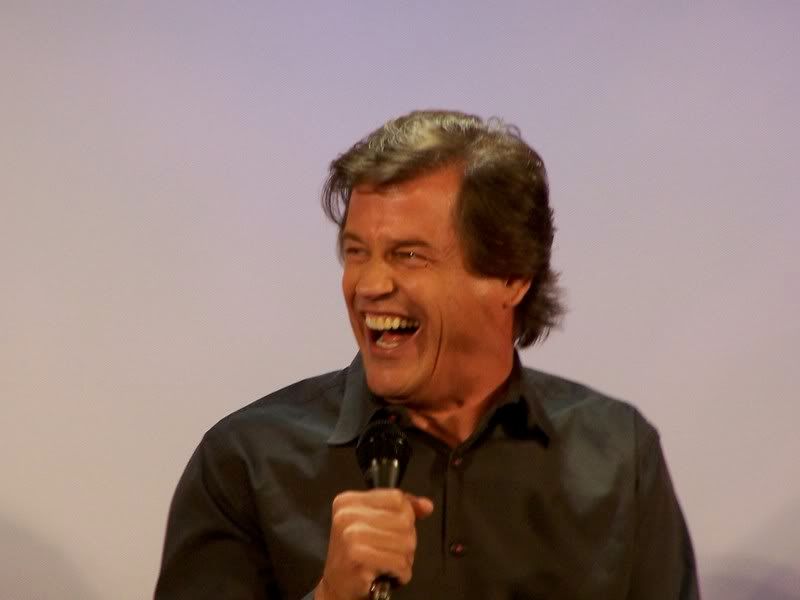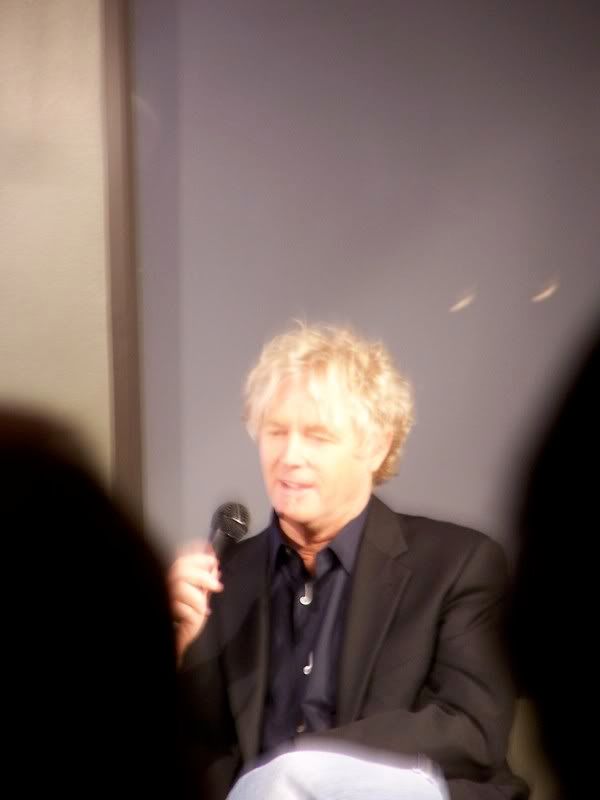The Greatest American Hero 25th Anniversary
A normal everyday man stumbles upon an object that grants him immense super powers. Green Lantern? Juggernaut? Super Chicken? No my friends, I am referring to the 80’s classic, “Greatest American Hero.” In case you’re too young to remember GAH, it’s basically your standard Boy-finds-super-suit, FBI-agent-finds-boy, FBI-agent-and-boy-team-up-to-fight-for-justice premise. Plus there’s Connie Sellecca.
But that’s as much recapping as I intend on writing. If you’ve never seen Greatest American Hero, Netflix it, Tivo it, borrow the complete series from one of your older friends. It’s cornball goodness as only 80’s television could deliver.
This story, however, is about a night of celebration and memories. A night, hosted by the gargantuan John Tesh (Connie Sellecca’s real-life husband), and featuring the creative mind that birthed TV shows like Hunter, The Rockford Files, and the ever-inspiring A-Team: Stephen J. Cannell. Mr. Cannell was a force back in the 80’s and you can tell. Looking at the man today, you might guess that he was the inspiration for Don Johnson’s “Sonny Crocket” on Miami Vice. Tanned, pinky ringed, and unaware of the existence of the top three buttons on his shirt, Mr. Cannell IS the 80’s.

This past Sunday night, I had the honor of attending The Greatest American Hero 25th Anniversary Reunion (hosted by the afore mentioned John Tesh). During the course of the night’s festivities I was introduced to a number of Hollywood individuals: producers, writers, an editor and some actors. The real treat for a behind-the-scenes junky such as myself, however, was the two gentlemen that were introduced towards the end of the night. As they stepped out onto the stage, I instantly guessed their claim to GAH fame. One gentleman was a stocky, bald, rough and tough kinda guy that looked like he could have been Cannell’s lead henchman. And the other guy was a skinny dazed gentleman with long brown wavy hair that I actually mistook for Journey frontman Steve Perry when I first saw him. I looked at these two guys and thought, “Okay we have stunt man and music writer.” I know stunt men. I’ve worked and been friends with many in my life, and the big bruiser was definitely reminiscent of any number of my old friends. And the Steve Perry guy was… well, Steve Perry guy. And I was absolutely right, but couldn’t have been more wrong.

Big bald henchman was actually Mike Post, the genius mind that not only wrote the music for the theme song and in-show music, but also wrote the theme songs for Hill Street Blues, A-team, Magnum P.I., Quantum Leap, Doogie Howser, and Law and Order. Mr. Post was a balls-out funny guy that knows his shit.
Steve Perry was actually Dennis Mandalone, the lead stuntman that doubled for the title character. Mr. Mandalone was a quiet guy, but everyone seemed to love him, and he was very humble in return. The best part about Mr. Mandalone, though, was when I got back home and googled his name only to find this amazing treasure…
http://theworstmusicvideos.com/bad-music-video9.html
Dear god, it’s a thing of ridiculous beauty! I guess I was more on the mark than I thought!
The actors were, well… actors. They all have nothing but fond memories of shooting episodes of The Greatest American Hero. They called themselves a family. They traded stories about laughing on set and hiding pregnancies. They were perfectly joyful people recollecting happier times. I don’t mean to diminish the actors’ perspective, but you must forgive me. I’ve seen about a hundred of these kinds of shows before. And whether it’s Cid Caesar and the brilliant fossils of “Your Show of Shows,” the uncomfortable and jet-lagged writers and host of “Late Night with Conan O’Brian,” or the nerd circle jerk that was the writers and voices of “Futurama,” most every group hits the same standard points. Well this group hit their points and recounted their unique stories, and it was all very pleasant.



The following points of interest were brought up during the course of the show:
• The GAH insignia was inspired by a pair of Scissors still sitting on Mr. Cannell’s desk.
• Robert Culp used Merlin as his inspiration for the character of Bill Maxwell.
• Connie Sellecca stole one of the suits and gave it to her children to wear for Halloween.
• This was the first time in 25 years that this whole group got together for something like this.
• According to Connie, John Tesh is a very busy man (this was the most shocking statement of the night for me).
• Mr. Cannell has written a script for a GAH feature film that William Katt (the title character) has read and loves.
And that was the night. Mr. Tesh ended the evening with a round of applause for the cast, and the room slowly dispersed into the cool Hollywood night.
Walking back to my car, I started thinking about the feature film idea, and whether this idea would work in today’s superhero chic society. I flashed back on Warner Bros. mastermind Jeff Robinov and his “Dark superhero movies = awesome superhero movies” theory. I also started to think of a good comparison to today’s TV market. You couldn’t compare GAH to Heroes as that show is all about multiple people with multiple powers. The better comparison would be to a show close to my hate, Smallville. Both GAH and Smallville focus on one guy that’s “finding” his powers and his place in society. Both stories feature older, and wiser characters that not only know the lead character’s secret, but also help guide him to fulfill his destiny.
The biggest difference between the two shows is ultimately style. GAH was, in retrospect, a romantic comedy. That show lived and breathed with its humorous take on what life would be like if you actually did stumble upon super powers. The jokes, whether you find them too cornball or dated, were all done with realism and respect.
Smallville, on the other hand, follows Mr. Robinov’s theory of “dark = good.” Clark is a brooding heap of angst and grief that is doomed to fight one monster after another in an everlasting battle of Krypto-freaks. There is no humor in Smallville. There is no love or happiness. Everything in Smallville is destined for destruction.
It’s this comparison between GAH and Smallville that proves Mr. Robinov wrong. Smallville is dark and brooding and is NOT (in my opinion) any better than GAH. GAH is goofy and cornball and (in my opinion) a sweet story that could easily work in today’s superhero friendly world. The “trick” that Mr. Robinov claims to have figured out is wrong. You want to know the “trick” to making a successful comic book based property…? Don’t worry yourself about darkness, just focus on realism. I believe any comic book character has the potential to become a great film or TV show if you commit yourself to staying as realistic as possible.
“What do you mean realistic,” you’re asking me. “We’re talking about people that can fly and shoot lasers out of their eyeballs!”
Okay. That’s true. Comic book adaptations will always have unrealistic attributes to showcase, but the star of the show is never the power. Iron Man would not have been anywhere CLOSE to as good a film as it was without the charm and realism brought by Robert Downy Jr. It’s the character, stupid! Treat the characters and situation that they are involved in with realism and honesty, and you will end up with a better product.
And that was the draw to The Great American Hero, on this night 25 years after the show’s finale. Mr. Cannell had to fight constantly with the suits at ABC to keep the characters and situations as realistic as possible, and the show was that much better for it. In the end, the suits won, as they always end up doing, and the show suffered, floundered and ultimately failed. But, luckily for us, we can ignore the faults washed away by time and focus on the highlights that we are left with. And, believe it or not, I choose to see The Greatest American Hero for what it was: heart filled romantic parody of super hero bravado, unmatched a quarter century later on TV or film.
